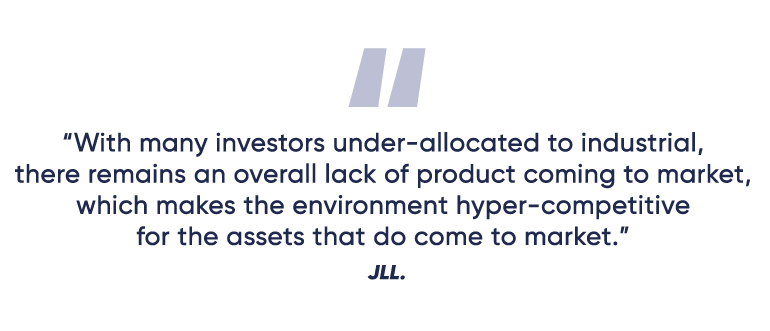
Explore the surge in demand for industrial real estate
Learn why offshore entities and high net worth investors are investing in industrial real estate
Investors looking to invest in industrial real estate should have an idea of what purpose the investment adds to their portfolio. There are many factors to consider ranging from upgrading and selling the property, to finding a long-term tenant, or whether the investor is looking to occupy the property as a tenant.
Wealth Migrate believes that future-proofing an investment is important especially as industrial real estate tends to be a long-term asset that investors hold for income-generation or for the increase in property value. Future-proofing an industrial asset will hold an investor in good stead if one considers selling the asset or keeping it to generate a passive income.
Factors to consider when investing in industrial real estate
As discussed in our previous article on eCommerce and logistics causing a surge in demand for these types of properties, one should consider the convenience of a good transport network, infrastructure, potential redevelopment and whether the property could provide a mix of office and industrial buildings to boost its profitability. Flexibility is a key factor for investors that want to get the most value out of industrial real estate investments.1
This adds a further benefit of diversification to an investment portfolio as industrial real estate is often a hybrid of both and ensures that the property is more appealing to a larger target market if it is multi-functional. The zoning restrictions on the land and buildings will contribute to the possibility of it being redeveloped in the future, it’s important that investors have clear insight into what this entails and the regulations covering this area.2 Especially as to what permits have been granted and what permits they will need to convert it into different spaces for offices, warehousing, cold storage, data centres and so forth.
The good news is that industrial tenants tend to sign longer leases as the types of buildings and land needed means that tenants often build specific facilities on the premises. These types of leases are typically from three to 10 years in nature, and even longer with rights to renew the lease. Wealth Migrate advocates for the certainty that such contracts provide, as investors can then determine the income potential of the industrial property by the parties involved, their credit history (in case of default), the income that will be generated, and even factor in the nature of the tenant’s company and whether it’s likely to remain in business over the period of the lease.
Uncertain markets versus the growth in eCommerce and logistics
As eCommerce expands and the demand for transport networks increases, which are essential to supply chains to ensure that not only is the production and manufacture of the goods in good stead, delivery of it to the distribution centres and down the chain to the consumer is faster and more convenient. Post-COVID-19, commercial real estate has seen a record jump in investment, but while this is gaining momentum, investors still are carefully considering the current uncertainty in the market. There is still a shortage in supply chains from the war with Russia and the Ukraine, and the added challenges of inflation and higher interest rates.3

The strong fundamentals of industrial real estate
The industrial property sector has received a boost from the pandemic, although these fundamentals were largely already in play prior to COVID-19.
Some of the strong fundamental factors include:4
- An unceasing demand for warehousing and property rentals.
- The rapid increase in online shopping and tenant concerns about supply chain shortages, resulting in a need for more warehousing space for extra stock.
- Other trends driving industrial acquisitions include barriers to new development in certain markets, population growth, and increasing construction costs.
Industrial deals have been gaining more global attention such as Stockbridge Capital Group’s partnership with National Pension Service of Seoul to acquire a $2 billion (USD) USA-based industrial property portfolio with 14.3 million square feet and featuring tenants the likes of Amazon, Walmart, and Target.5 The spotlight is currently on industrial real estate as KRR & Co, a global investment firm, closes a deal for about 100 warehouses for an estimated $800 million (USD).6
Since the pandemic, the safety net of investing in hotels, office and retail has largely changed over to industrial real estate, especially as eCommerce grew quite significantly during and post-COVID-19. This rise in foreign investment is also due to what are termed ‘opportunities of scale’.7 Large industrial portfolios offer a lot of capital in one go, and investors see an opportunity to buy into low-yield markets as the barriers will keep rentals increasing in price – from government laws and restrictions and limited land – narrowing down the types of properties available for eCommerce and logistics.8
Industrial real estate’s appeal to ultra-high-net-worth investors and foreign entities as a safe bet
In the race for space, logistics is becoming a frontrunner for investment as demand cannot keep up with supply. There is a large amount of construction and new warehousing premises being built, but the demand is now far outpacing the supply.
According to JLL, this shortage in supply is below 5% in vacancy levels for most major logistics markets.9 While the usual types of investors are playing in this market such as REITS, pension funds, insurance companies, and private equity firms,10 ultra-high-net-worth investors and foreign entities have taken notice of this increased activity and are also investing in industrial real estate as a safe bet.

It’s worth noting that core buyers are targeting an average internal rate of return (IRR) of 5%-6%, while value add investors are looking for an IRR of 8% or higher.11 In this regard, Wealth Migrate provides investors with a higher IRR than the market average. Wealth Migrate’s latest industrial investment offered a net IRR of 17.7%, a deal that was quickly fully funded.
Wealth Migrate can offer these types of returns to investors through a partnership with DWG Capital Partners (DWG). Judd Dunning as President of DWG specialises in, “providing strategic, institutional-level advisory services for stabilized, value-add and distressed retail, office, industrial, multifamily and development assets”.12 The fully funded industrial property investment featured a sale-leaseback structure – a commercial transaction where an owner and occupier sell their real estate asset, and then leases it back as a tenant from the new owner. This creates a stable long-term asset that produces rental income for the new owner, which becomes a passive monthly cash flow to investors.
As part of an ongoing educational series, our next article will investigate the realities of the 100-year life, and how investors should go about wealth creation and protection with this increased longevity in mind.
Find more Wealth Migrate content:
Read our investment articles and listen to the podcasts. We cover the topics of diversification, structured notes, purpose-built-co-living, and industrial real estate. Click below for the full list of Wealth Migrate content.
1 Guest writer. (January 2018). ‘Understanding the different types of industrial property’. Retrieved from Savills.
2 JLL. (September 2020). ‘How to approach an investment in industrial property’. Retrieved from JLL.
3 Botwinick, R. (March 2021). ’Industrial real estate is a safe haven in these uncertain times’. Retrieved from Forbes.
4 JLL. (May 2022). ‘Real estate investment hits record as headwinds emerge’. Retrieved from JLL.
5 Stanton, R. (December 2020). ‘NPS and Stockbridge form new industrial real estate joint venture’. Retrieved from Business Wire.
6 Bloomberg. (December 2020). ‘KKR nears US$800m US warehouse deal with e-commerce booming’. Retrieved from The Business Times.
7 JLL. (May 2022). ‘Real estate investment hits record as headwinds emerge’. Retrieved from JLL.
8 Harmse, N., and Robson, W. (March 2021). ’What drove 2021 real estate returns?’. Retrieved from MSCI.
9 JLL. (September 2020). ‘How to approach an investment in industrial property’. Retrieved from JLL.
10 Harmse, N., and Robson, W. (March 2021). ’What drove 2021 real estate returns?’. Retrieved from MSCI.
11 Kirk, P. (December 2020). ’Every Type of Investor Is Looking into U.S. Industrial Properties’. Retrieved from Wealth Management.com.
12 DWG Capital Partners. (2021). ’Our team’. Retrieved from DWG Capital Partners.